Reviewing 'The Orenda': An Analysis of History, War, and Religion
VerifiedAdded on 2023/06/10
|7
|2282
|361
Essay
AI Summary
This essay provides a critical review of Joseph Boyden's novel 'The Orenda,' focusing on its portrayal of Canadian history through the lenses of gender, war, and religion. The analysis examines how Boyden presents the perspectives of three central characters – Bird, Snow Falls, and Christophe – within the context of 17th-century Canada. The review assesses the accuracy and significance of these themes compared to historical accounts, considering the roles of men and women, the impact of warfare on indigenous communities and French colonialists, and the religious tensions between Christianity and indigenous beliefs. The essay argues that while Boyden offers a balanced view of gender roles, the novel accurately reflects the continuous conflicts of war and the forced conversion of indigenous people, aligning with historical narratives of the period.
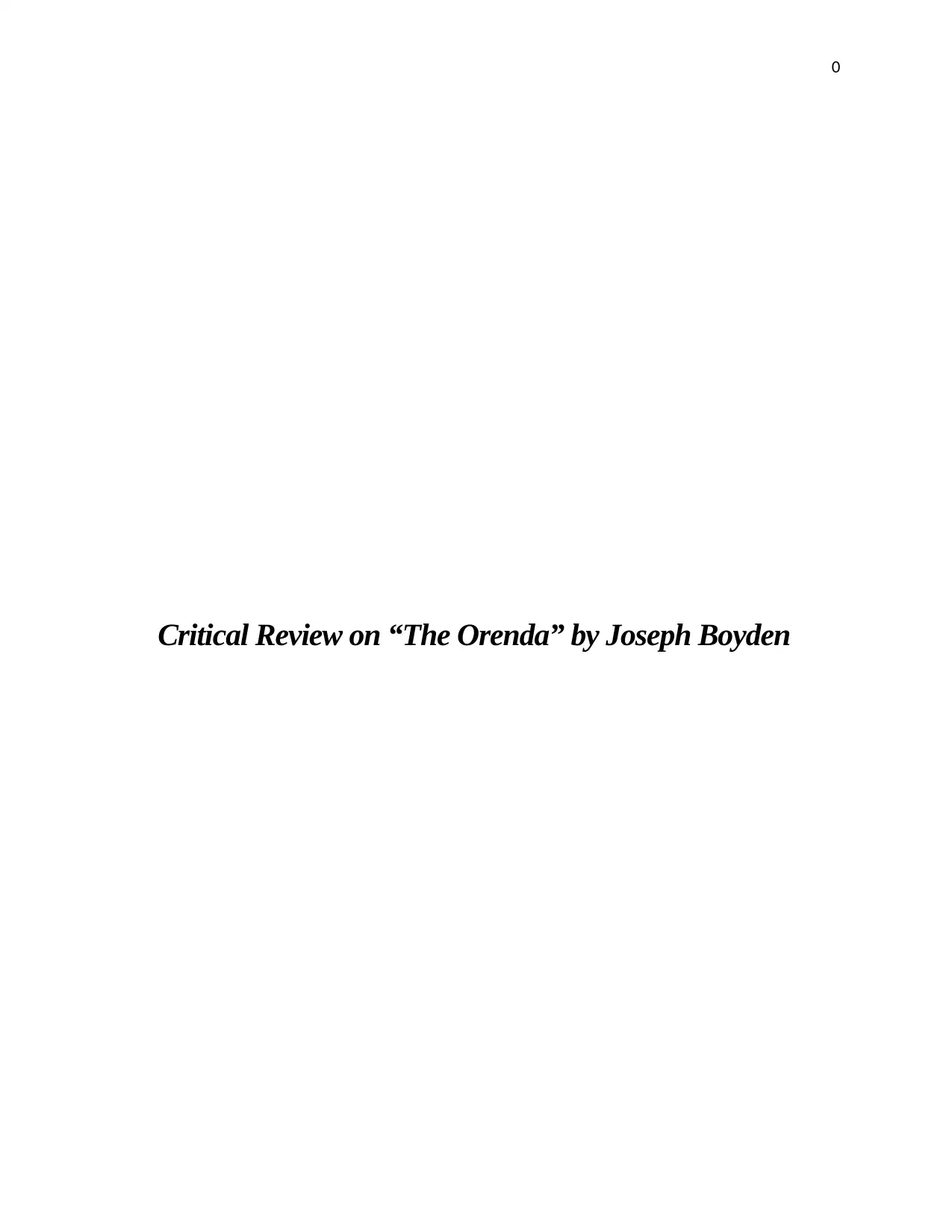
0
Critical Review on “The Orenda” by Joseph Boyden
Critical Review on “The Orenda” by Joseph Boyden
Paraphrase This Document
Need a fresh take? Get an instant paraphrase of this document with our AI Paraphraser
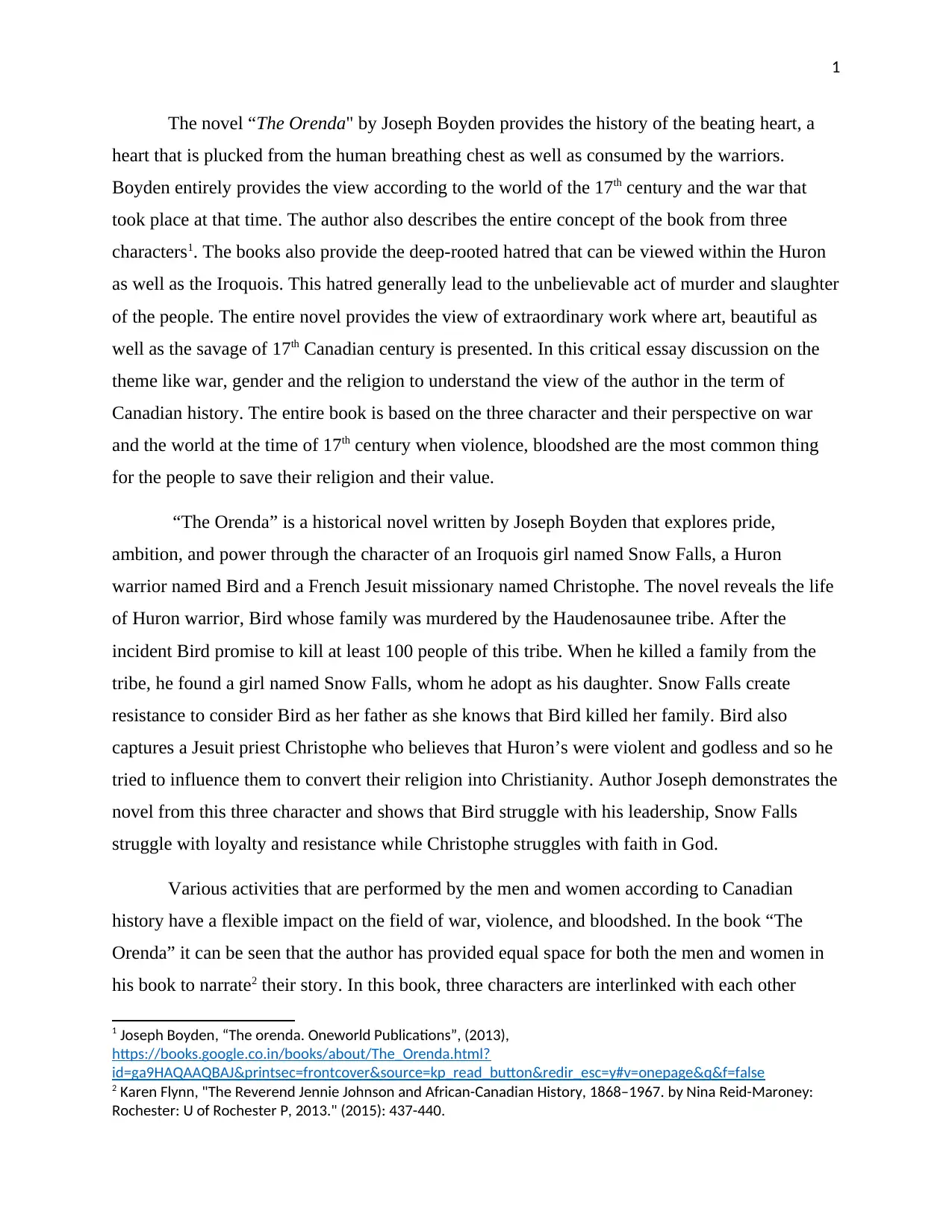
1
The novel “The Orenda" by Joseph Boyden provides the history of the beating heart, a
heart that is plucked from the human breathing chest as well as consumed by the warriors.
Boyden entirely provides the view according to the world of the 17th century and the war that
took place at that time. The author also describes the entire concept of the book from three
characters1. The books also provide the deep-rooted hatred that can be viewed within the Huron
as well as the Iroquois. This hatred generally lead to the unbelievable act of murder and slaughter
of the people. The entire novel provides the view of extraordinary work where art, beautiful as
well as the savage of 17th Canadian century is presented. In this critical essay discussion on the
theme like war, gender and the religion to understand the view of the author in the term of
Canadian history. The entire book is based on the three character and their perspective on war
and the world at the time of 17th century when violence, bloodshed are the most common thing
for the people to save their religion and their value.
“The Orenda” is a historical novel written by Joseph Boyden that explores pride,
ambition, and power through the character of an Iroquois girl named Snow Falls, a Huron
warrior named Bird and a French Jesuit missionary named Christophe. The novel reveals the life
of Huron warrior, Bird whose family was murdered by the Haudenosaunee tribe. After the
incident Bird promise to kill at least 100 people of this tribe. When he killed a family from the
tribe, he found a girl named Snow Falls, whom he adopt as his daughter. Snow Falls create
resistance to consider Bird as her father as she knows that Bird killed her family. Bird also
captures a Jesuit priest Christophe who believes that Huron’s were violent and godless and so he
tried to influence them to convert their religion into Christianity. Author Joseph demonstrates the
novel from this three character and shows that Bird struggle with his leadership, Snow Falls
struggle with loyalty and resistance while Christophe struggles with faith in God.
Various activities that are performed by the men and women according to Canadian
history have a flexible impact on the field of war, violence, and bloodshed. In the book “The
Orenda” it can be seen that the author has provided equal space for both the men and women in
his book to narrate2 their story. In this book, three characters are interlinked with each other
1 Joseph Boyden, “The orenda. Oneworld Publications”, (2013),
https://books.google.co.in/books/about/The_Orenda.html?
id=ga9HAQAAQBAJ&printsec=frontcover&source=kp_read_button&redir_esc=y#v=onepage&q&f=false
2 Karen Flynn, "The Reverend Jennie Johnson and African-Canadian History, 1868–1967. by Nina Reid-Maroney:
Rochester: U of Rochester P, 2013." (2015): 437-440.
The novel “The Orenda" by Joseph Boyden provides the history of the beating heart, a
heart that is plucked from the human breathing chest as well as consumed by the warriors.
Boyden entirely provides the view according to the world of the 17th century and the war that
took place at that time. The author also describes the entire concept of the book from three
characters1. The books also provide the deep-rooted hatred that can be viewed within the Huron
as well as the Iroquois. This hatred generally lead to the unbelievable act of murder and slaughter
of the people. The entire novel provides the view of extraordinary work where art, beautiful as
well as the savage of 17th Canadian century is presented. In this critical essay discussion on the
theme like war, gender and the religion to understand the view of the author in the term of
Canadian history. The entire book is based on the three character and their perspective on war
and the world at the time of 17th century when violence, bloodshed are the most common thing
for the people to save their religion and their value.
“The Orenda” is a historical novel written by Joseph Boyden that explores pride,
ambition, and power through the character of an Iroquois girl named Snow Falls, a Huron
warrior named Bird and a French Jesuit missionary named Christophe. The novel reveals the life
of Huron warrior, Bird whose family was murdered by the Haudenosaunee tribe. After the
incident Bird promise to kill at least 100 people of this tribe. When he killed a family from the
tribe, he found a girl named Snow Falls, whom he adopt as his daughter. Snow Falls create
resistance to consider Bird as her father as she knows that Bird killed her family. Bird also
captures a Jesuit priest Christophe who believes that Huron’s were violent and godless and so he
tried to influence them to convert their religion into Christianity. Author Joseph demonstrates the
novel from this three character and shows that Bird struggle with his leadership, Snow Falls
struggle with loyalty and resistance while Christophe struggles with faith in God.
Various activities that are performed by the men and women according to Canadian
history have a flexible impact on the field of war, violence, and bloodshed. In the book “The
Orenda” it can be seen that the author has provided equal space for both the men and women in
his book to narrate2 their story. In this book, three characters are interlinked with each other
1 Joseph Boyden, “The orenda. Oneworld Publications”, (2013),
https://books.google.co.in/books/about/The_Orenda.html?
id=ga9HAQAAQBAJ&printsec=frontcover&source=kp_read_button&redir_esc=y#v=onepage&q&f=false
2 Karen Flynn, "The Reverend Jennie Johnson and African-Canadian History, 1868–1967. by Nina Reid-Maroney:
Rochester: U of Rochester P, 2013." (2015): 437-440.
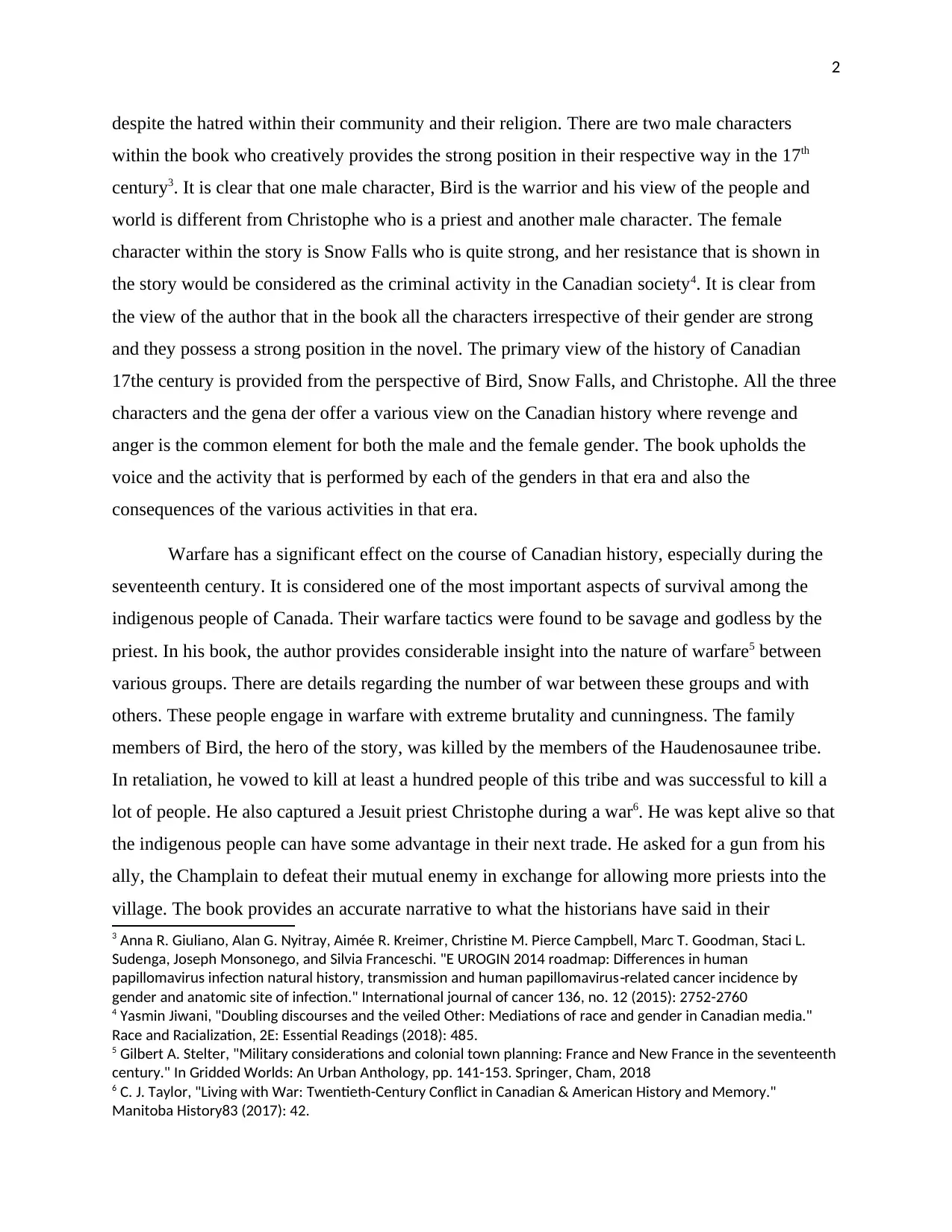
2
despite the hatred within their community and their religion. There are two male characters
within the book who creatively provides the strong position in their respective way in the 17th
century3. It is clear that one male character, Bird is the warrior and his view of the people and
world is different from Christophe who is a priest and another male character. The female
character within the story is Snow Falls who is quite strong, and her resistance that is shown in
the story would be considered as the criminal activity in the Canadian society4. It is clear from
the view of the author that in the book all the characters irrespective of their gender are strong
and they possess a strong position in the novel. The primary view of the history of Canadian
17the century is provided from the perspective of Bird, Snow Falls, and Christophe. All the three
characters and the gena der offer a various view on the Canadian history where revenge and
anger is the common element for both the male and the female gender. The book upholds the
voice and the activity that is performed by each of the genders in that era and also the
consequences of the various activities in that era.
Warfare has a significant effect on the course of Canadian history, especially during the
seventeenth century. It is considered one of the most important aspects of survival among the
indigenous people of Canada. Their warfare tactics were found to be savage and godless by the
priest. In his book, the author provides considerable insight into the nature of warfare5 between
various groups. There are details regarding the number of war between these groups and with
others. These people engage in warfare with extreme brutality and cunningness. The family
members of Bird, the hero of the story, was killed by the members of the Haudenosaunee tribe.
In retaliation, he vowed to kill at least a hundred people of this tribe and was successful to kill a
lot of people. He also captured a Jesuit priest Christophe during a war6. He was kept alive so that
the indigenous people can have some advantage in their next trade. He asked for a gun from his
ally, the Champlain to defeat their mutual enemy in exchange for allowing more priests into the
village. The book provides an accurate narrative to what the historians have said in their
3 Anna R. Giuliano, Alan G. Nyitray, Aimée R. Kreimer, Christine M. Pierce Campbell, Marc T. Goodman, Staci L.
Sudenga, Joseph Monsonego, and Silvia Franceschi. "E UROGIN 2014 roadmap: Differences in human
papillomavirus infection natural history, transmission and human papillomavirus related cancer incidence by‐
gender and anatomic site of infection." International journal of cancer 136, no. 12 (2015): 2752-2760
4 Yasmin Jiwani, "Doubling discourses and the veiled Other: Mediations of race and gender in Canadian media."
Race and Racialization, 2E: Essential Readings (2018): 485.
5 Gilbert A. Stelter, "Military considerations and colonial town planning: France and New France in the seventeenth
century." In Gridded Worlds: An Urban Anthology, pp. 141-153. Springer, Cham, 2018
6 C. J. Taylor, "Living with War: Twentieth-Century Conflict in Canadian & American History and Memory."
Manitoba History83 (2017): 42.
despite the hatred within their community and their religion. There are two male characters
within the book who creatively provides the strong position in their respective way in the 17th
century3. It is clear that one male character, Bird is the warrior and his view of the people and
world is different from Christophe who is a priest and another male character. The female
character within the story is Snow Falls who is quite strong, and her resistance that is shown in
the story would be considered as the criminal activity in the Canadian society4. It is clear from
the view of the author that in the book all the characters irrespective of their gender are strong
and they possess a strong position in the novel. The primary view of the history of Canadian
17the century is provided from the perspective of Bird, Snow Falls, and Christophe. All the three
characters and the gena der offer a various view on the Canadian history where revenge and
anger is the common element for both the male and the female gender. The book upholds the
voice and the activity that is performed by each of the genders in that era and also the
consequences of the various activities in that era.
Warfare has a significant effect on the course of Canadian history, especially during the
seventeenth century. It is considered one of the most important aspects of survival among the
indigenous people of Canada. Their warfare tactics were found to be savage and godless by the
priest. In his book, the author provides considerable insight into the nature of warfare5 between
various groups. There are details regarding the number of war between these groups and with
others. These people engage in warfare with extreme brutality and cunningness. The family
members of Bird, the hero of the story, was killed by the members of the Haudenosaunee tribe.
In retaliation, he vowed to kill at least a hundred people of this tribe and was successful to kill a
lot of people. He also captured a Jesuit priest Christophe during a war6. He was kept alive so that
the indigenous people can have some advantage in their next trade. He asked for a gun from his
ally, the Champlain to defeat their mutual enemy in exchange for allowing more priests into the
village. The book provides an accurate narrative to what the historians have said in their
3 Anna R. Giuliano, Alan G. Nyitray, Aimée R. Kreimer, Christine M. Pierce Campbell, Marc T. Goodman, Staci L.
Sudenga, Joseph Monsonego, and Silvia Franceschi. "E UROGIN 2014 roadmap: Differences in human
papillomavirus infection natural history, transmission and human papillomavirus related cancer incidence by‐
gender and anatomic site of infection." International journal of cancer 136, no. 12 (2015): 2752-2760
4 Yasmin Jiwani, "Doubling discourses and the veiled Other: Mediations of race and gender in Canadian media."
Race and Racialization, 2E: Essential Readings (2018): 485.
5 Gilbert A. Stelter, "Military considerations and colonial town planning: France and New France in the seventeenth
century." In Gridded Worlds: An Urban Anthology, pp. 141-153. Springer, Cham, 2018
6 C. J. Taylor, "Living with War: Twentieth-Century Conflict in Canadian & American History and Memory."
Manitoba History83 (2017): 42.
⊘ This is a preview!⊘
Do you want full access?
Subscribe today to unlock all pages.

Trusted by 1+ million students worldwide
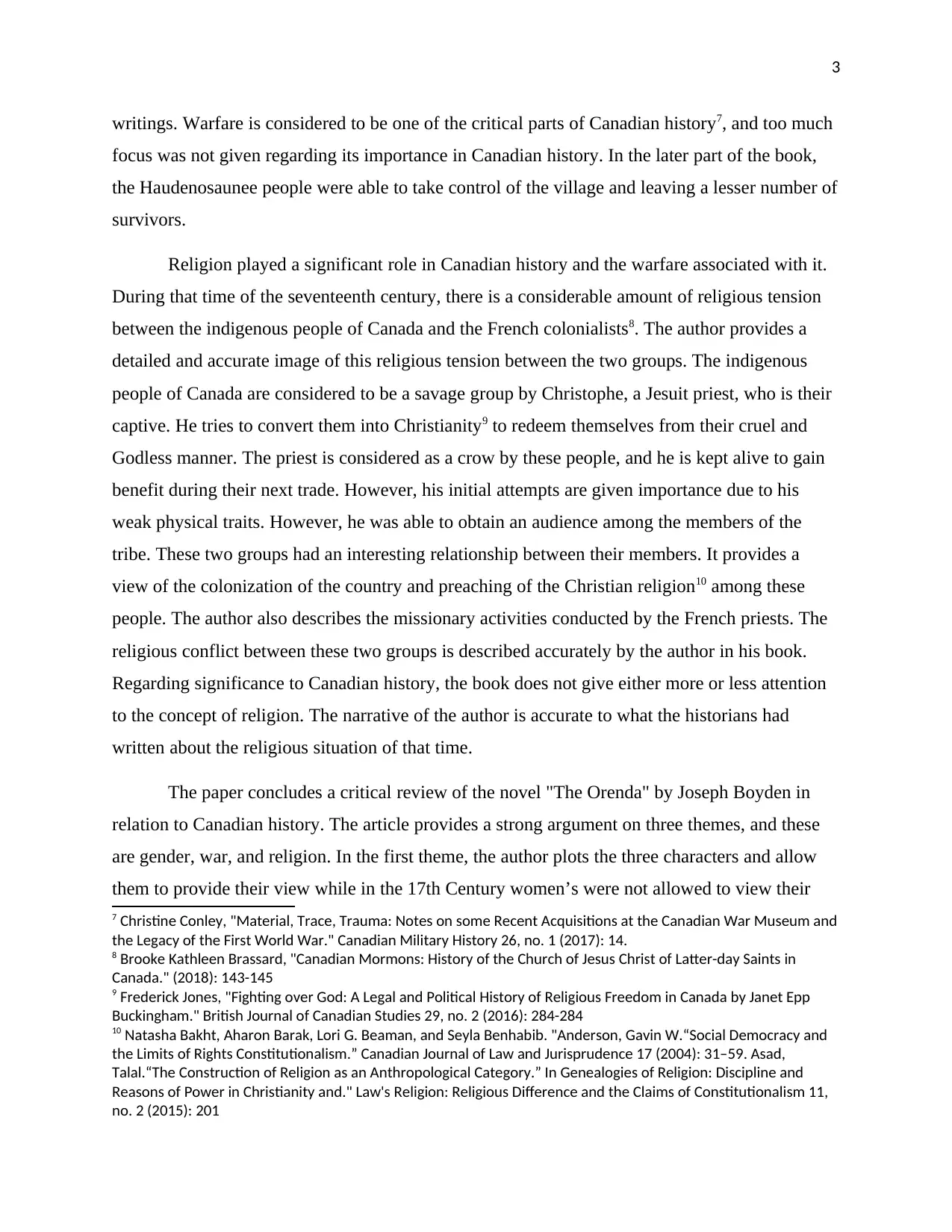
3
writings. Warfare is considered to be one of the critical parts of Canadian history7, and too much
focus was not given regarding its importance in Canadian history. In the later part of the book,
the Haudenosaunee people were able to take control of the village and leaving a lesser number of
survivors.
Religion played a significant role in Canadian history and the warfare associated with it.
During that time of the seventeenth century, there is a considerable amount of religious tension
between the indigenous people of Canada and the French colonialists8. The author provides a
detailed and accurate image of this religious tension between the two groups. The indigenous
people of Canada are considered to be a savage group by Christophe, a Jesuit priest, who is their
captive. He tries to convert them into Christianity9 to redeem themselves from their cruel and
Godless manner. The priest is considered as a crow by these people, and he is kept alive to gain
benefit during their next trade. However, his initial attempts are given importance due to his
weak physical traits. However, he was able to obtain an audience among the members of the
tribe. These two groups had an interesting relationship between their members. It provides a
view of the colonization of the country and preaching of the Christian religion10 among these
people. The author also describes the missionary activities conducted by the French priests. The
religious conflict between these two groups is described accurately by the author in his book.
Regarding significance to Canadian history, the book does not give either more or less attention
to the concept of religion. The narrative of the author is accurate to what the historians had
written about the religious situation of that time.
The paper concludes a critical review of the novel "The Orenda" by Joseph Boyden in
relation to Canadian history. The article provides a strong argument on three themes, and these
are gender, war, and religion. In the first theme, the author plots the three characters and allow
them to provide their view while in the 17th Century women’s were not allowed to view their
7 Christine Conley, "Material, Trace, Trauma: Notes on some Recent Acquisitions at the Canadian War Museum and
the Legacy of the First World War." Canadian Military History 26, no. 1 (2017): 14.
8 Brooke Kathleen Brassard, "Canadian Mormons: History of the Church of Jesus Christ of Latter-day Saints in
Canada." (2018): 143-145
9 Frederick Jones, "Fighting over God: A Legal and Political History of Religious Freedom in Canada by Janet Epp
Buckingham." British Journal of Canadian Studies 29, no. 2 (2016): 284-284
10 Natasha Bakht, Aharon Barak, Lori G. Beaman, and Seyla Benhabib. "Anderson, Gavin W.“Social Democracy and
the Limits of Rights Constitutionalism.” Canadian Journal of Law and Jurisprudence 17 (2004): 31–59. Asad,
Talal.“The Construction of Religion as an Anthropological Category.” In Genealogies of Religion: Discipline and
Reasons of Power in Christianity and." Law's Religion: Religious Difference and the Claims of Constitutionalism 11,
no. 2 (2015): 201
writings. Warfare is considered to be one of the critical parts of Canadian history7, and too much
focus was not given regarding its importance in Canadian history. In the later part of the book,
the Haudenosaunee people were able to take control of the village and leaving a lesser number of
survivors.
Religion played a significant role in Canadian history and the warfare associated with it.
During that time of the seventeenth century, there is a considerable amount of religious tension
between the indigenous people of Canada and the French colonialists8. The author provides a
detailed and accurate image of this religious tension between the two groups. The indigenous
people of Canada are considered to be a savage group by Christophe, a Jesuit priest, who is their
captive. He tries to convert them into Christianity9 to redeem themselves from their cruel and
Godless manner. The priest is considered as a crow by these people, and he is kept alive to gain
benefit during their next trade. However, his initial attempts are given importance due to his
weak physical traits. However, he was able to obtain an audience among the members of the
tribe. These two groups had an interesting relationship between their members. It provides a
view of the colonization of the country and preaching of the Christian religion10 among these
people. The author also describes the missionary activities conducted by the French priests. The
religious conflict between these two groups is described accurately by the author in his book.
Regarding significance to Canadian history, the book does not give either more or less attention
to the concept of religion. The narrative of the author is accurate to what the historians had
written about the religious situation of that time.
The paper concludes a critical review of the novel "The Orenda" by Joseph Boyden in
relation to Canadian history. The article provides a strong argument on three themes, and these
are gender, war, and religion. In the first theme, the author plots the three characters and allow
them to provide their view while in the 17th Century women’s were not allowed to view their
7 Christine Conley, "Material, Trace, Trauma: Notes on some Recent Acquisitions at the Canadian War Museum and
the Legacy of the First World War." Canadian Military History 26, no. 1 (2017): 14.
8 Brooke Kathleen Brassard, "Canadian Mormons: History of the Church of Jesus Christ of Latter-day Saints in
Canada." (2018): 143-145
9 Frederick Jones, "Fighting over God: A Legal and Political History of Religious Freedom in Canada by Janet Epp
Buckingham." British Journal of Canadian Studies 29, no. 2 (2016): 284-284
10 Natasha Bakht, Aharon Barak, Lori G. Beaman, and Seyla Benhabib. "Anderson, Gavin W.“Social Democracy and
the Limits of Rights Constitutionalism.” Canadian Journal of Law and Jurisprudence 17 (2004): 31–59. Asad,
Talal.“The Construction of Religion as an Anthropological Category.” In Genealogies of Religion: Discipline and
Reasons of Power in Christianity and." Law's Religion: Religious Difference and the Claims of Constitutionalism 11,
no. 2 (2015): 201
Paraphrase This Document
Need a fresh take? Get an instant paraphrase of this document with our AI Paraphraser
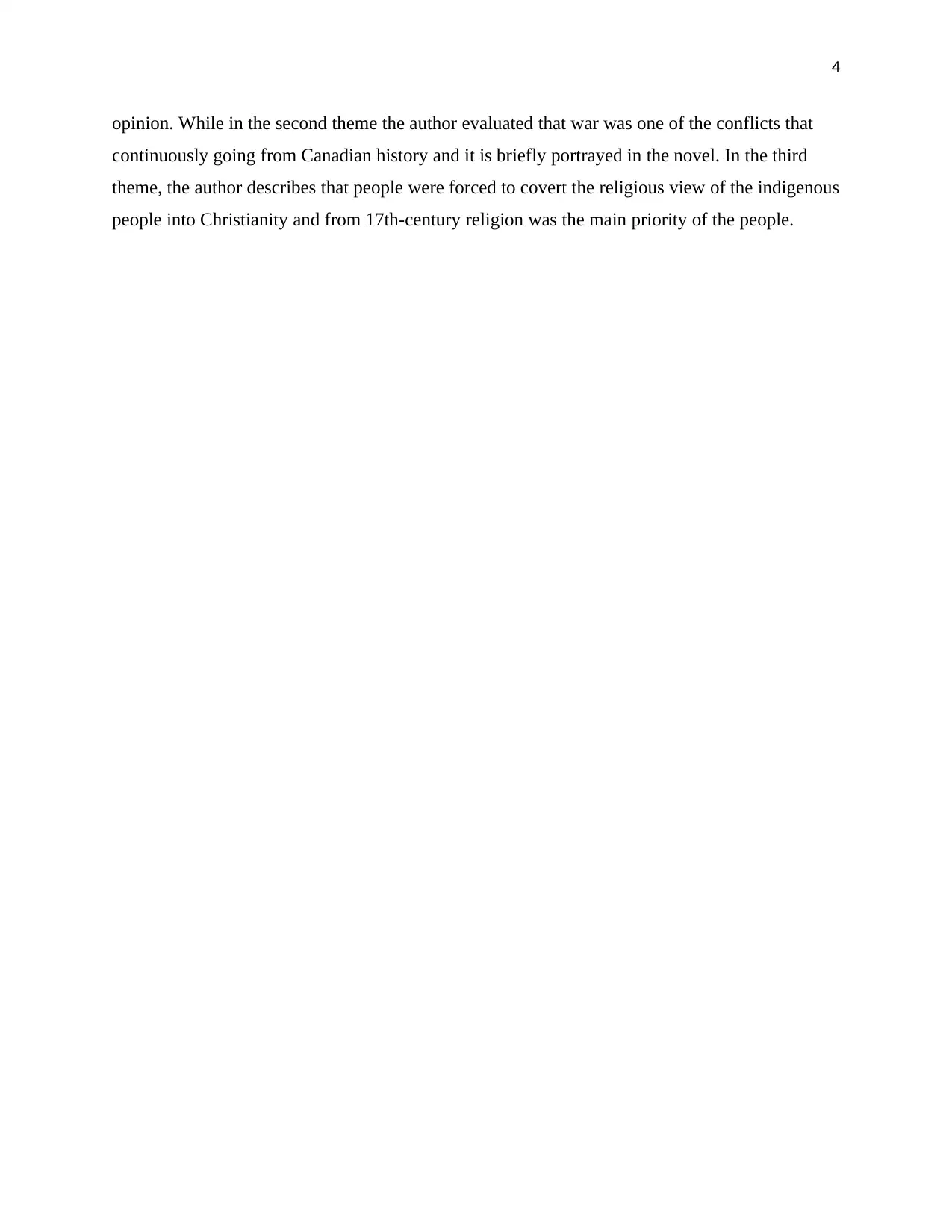
4
opinion. While in the second theme the author evaluated that war was one of the conflicts that
continuously going from Canadian history and it is briefly portrayed in the novel. In the third
theme, the author describes that people were forced to covert the religious view of the indigenous
people into Christianity and from 17th-century religion was the main priority of the people.
opinion. While in the second theme the author evaluated that war was one of the conflicts that
continuously going from Canadian history and it is briefly portrayed in the novel. In the third
theme, the author describes that people were forced to covert the religious view of the indigenous
people into Christianity and from 17th-century religion was the main priority of the people.
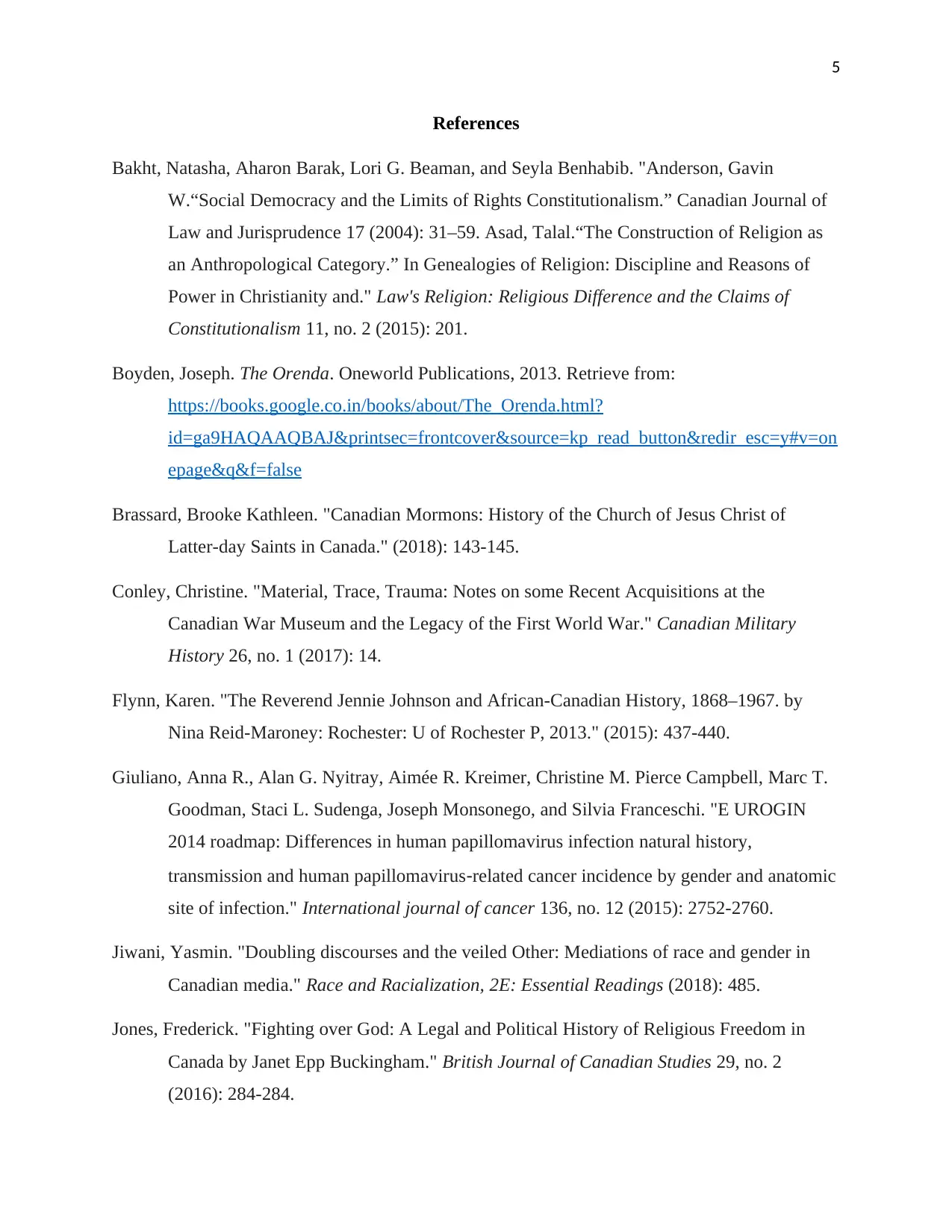
5
References
Bakht, Natasha, Aharon Barak, Lori G. Beaman, and Seyla Benhabib. "Anderson, Gavin
W.“Social Democracy and the Limits of Rights Constitutionalism.” Canadian Journal of
Law and Jurisprudence 17 (2004): 31–59. Asad, Talal.“The Construction of Religion as
an Anthropological Category.” In Genealogies of Religion: Discipline and Reasons of
Power in Christianity and." Law's Religion: Religious Difference and the Claims of
Constitutionalism 11, no. 2 (2015): 201.
Boyden, Joseph. The Orenda. Oneworld Publications, 2013. Retrieve from:
https://books.google.co.in/books/about/The_Orenda.html?
id=ga9HAQAAQBAJ&printsec=frontcover&source=kp_read_button&redir_esc=y#v=on
epage&q&f=false
Brassard, Brooke Kathleen. "Canadian Mormons: History of the Church of Jesus Christ of
Latter-day Saints in Canada." (2018): 143-145.
Conley, Christine. "Material, Trace, Trauma: Notes on some Recent Acquisitions at the
Canadian War Museum and the Legacy of the First World War." Canadian Military
History 26, no. 1 (2017): 14.
Flynn, Karen. "The Reverend Jennie Johnson and African-Canadian History, 1868–1967. by
Nina Reid-Maroney: Rochester: U of Rochester P, 2013." (2015): 437-440.
Giuliano, Anna R., Alan G. Nyitray, Aimée R. Kreimer, Christine M. Pierce Campbell, Marc T.
Goodman, Staci L. Sudenga, Joseph Monsonego, and Silvia Franceschi. "E UROGIN
2014 roadmap: Differences in human papillomavirus infection natural history,
transmission and human papillomavirus‐related cancer incidence by gender and anatomic
site of infection." International journal of cancer 136, no. 12 (2015): 2752-2760.
Jiwani, Yasmin. "Doubling discourses and the veiled Other: Mediations of race and gender in
Canadian media." Race and Racialization, 2E: Essential Readings (2018): 485.
Jones, Frederick. "Fighting over God: A Legal and Political History of Religious Freedom in
Canada by Janet Epp Buckingham." British Journal of Canadian Studies 29, no. 2
(2016): 284-284.
References
Bakht, Natasha, Aharon Barak, Lori G. Beaman, and Seyla Benhabib. "Anderson, Gavin
W.“Social Democracy and the Limits of Rights Constitutionalism.” Canadian Journal of
Law and Jurisprudence 17 (2004): 31–59. Asad, Talal.“The Construction of Religion as
an Anthropological Category.” In Genealogies of Religion: Discipline and Reasons of
Power in Christianity and." Law's Religion: Religious Difference and the Claims of
Constitutionalism 11, no. 2 (2015): 201.
Boyden, Joseph. The Orenda. Oneworld Publications, 2013. Retrieve from:
https://books.google.co.in/books/about/The_Orenda.html?
id=ga9HAQAAQBAJ&printsec=frontcover&source=kp_read_button&redir_esc=y#v=on
epage&q&f=false
Brassard, Brooke Kathleen. "Canadian Mormons: History of the Church of Jesus Christ of
Latter-day Saints in Canada." (2018): 143-145.
Conley, Christine. "Material, Trace, Trauma: Notes on some Recent Acquisitions at the
Canadian War Museum and the Legacy of the First World War." Canadian Military
History 26, no. 1 (2017): 14.
Flynn, Karen. "The Reverend Jennie Johnson and African-Canadian History, 1868–1967. by
Nina Reid-Maroney: Rochester: U of Rochester P, 2013." (2015): 437-440.
Giuliano, Anna R., Alan G. Nyitray, Aimée R. Kreimer, Christine M. Pierce Campbell, Marc T.
Goodman, Staci L. Sudenga, Joseph Monsonego, and Silvia Franceschi. "E UROGIN
2014 roadmap: Differences in human papillomavirus infection natural history,
transmission and human papillomavirus‐related cancer incidence by gender and anatomic
site of infection." International journal of cancer 136, no. 12 (2015): 2752-2760.
Jiwani, Yasmin. "Doubling discourses and the veiled Other: Mediations of race and gender in
Canadian media." Race and Racialization, 2E: Essential Readings (2018): 485.
Jones, Frederick. "Fighting over God: A Legal and Political History of Religious Freedom in
Canada by Janet Epp Buckingham." British Journal of Canadian Studies 29, no. 2
(2016): 284-284.
⊘ This is a preview!⊘
Do you want full access?
Subscribe today to unlock all pages.

Trusted by 1+ million students worldwide
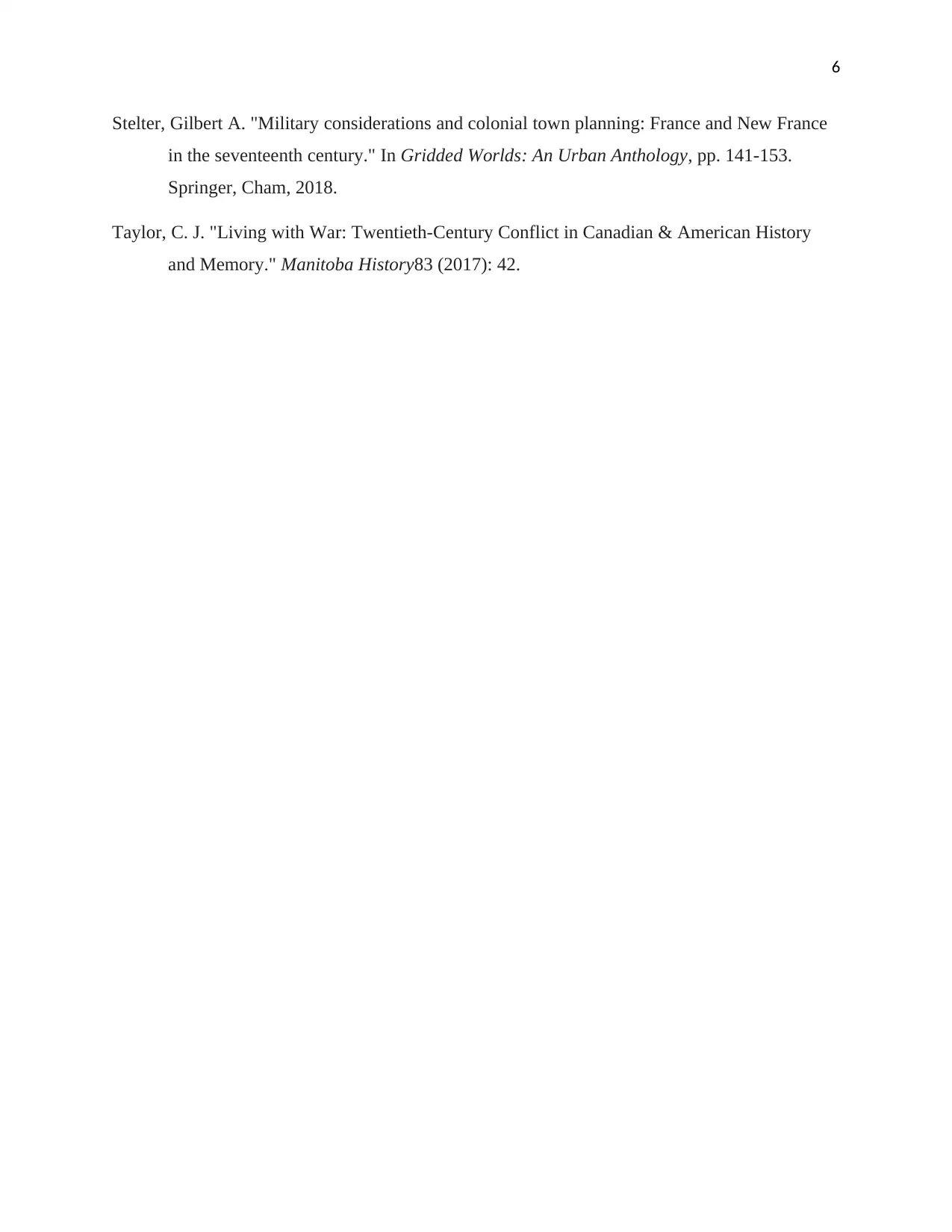
6
Stelter, Gilbert A. "Military considerations and colonial town planning: France and New France
in the seventeenth century." In Gridded Worlds: An Urban Anthology, pp. 141-153.
Springer, Cham, 2018.
Taylor, C. J. "Living with War: Twentieth-Century Conflict in Canadian & American History
and Memory." Manitoba History83 (2017): 42.
Stelter, Gilbert A. "Military considerations and colonial town planning: France and New France
in the seventeenth century." In Gridded Worlds: An Urban Anthology, pp. 141-153.
Springer, Cham, 2018.
Taylor, C. J. "Living with War: Twentieth-Century Conflict in Canadian & American History
and Memory." Manitoba History83 (2017): 42.
1 out of 7
Your All-in-One AI-Powered Toolkit for Academic Success.
+13062052269
info@desklib.com
Available 24*7 on WhatsApp / Email
![[object Object]](/_next/static/media/star-bottom.7253800d.svg)
Unlock your academic potential
Copyright © 2020–2025 A2Z Services. All Rights Reserved. Developed and managed by ZUCOL.